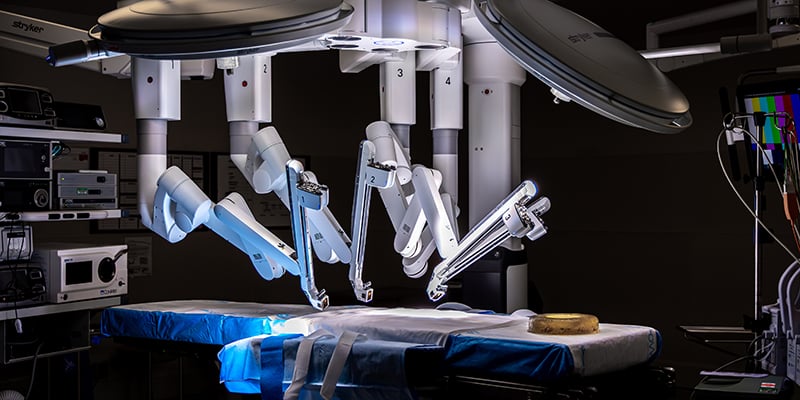Facing a 'very high-risk' tumor, Hall-of-Famer receives top care, including a new bladder, from Janet Kukreja, MD, and CU Cancer Center team
At a routine checkup this spring, doctors noticed something unusual in a CT scan of University of Colorado football coach Deion "Coach Prime" Sanders. The scan showed a mass on his bladder.
He was immediately referred to the CU Anschutz Medical Campus where he met with Janet Kukreja, MD, director of urologic oncology at the CU Cancer Center and UCHealth University of Colorado Hospital. After a thorough examination, Coach Prime was diagnosed with a malignant tumor in his bladder.
It was the most common form of bladder cancer, yet it was serious. The tumor hadn't reached the muscle layer but was considered "very high risk" with a 50% chance of recurring or even progressing after treatments in the bladder.
While Coach Prime could have gone anywhere for his medical care, he chose CU Anschutz to continue his treatment and care.
The sprawling academic medical campus, which includes two world-class hospitals and thousands of University of Colorado researchers, is a national leader in cancer care including bladder cancer.
Treatment advances: robotic surgery, new drug therapies
Using advanced robotic surgery, doctors at the CU Cancer Center can now treat bladder cancer in ways that are less invasive and traumatic for the patient. They have also developed innovative drug therapies and treatments for the disease.

Kukreja is one of a small group of surgeons in the U.S. who not only perform robotic removal of the entire cancerous bladder - called a radical cystectomy - but also robotic reconstruction of the organ. Kukreja performs over 150 radical cystectomies annually, using the Da Vinci Surgical System. UCHealth and the CU Cancer Center lead the nation in the number of procedures.
Kukreja, aka "Dr. K," and Coach Prime come from different professional worlds yet share things in common. Both lead dynamic teams in high-stakes arenas. Sanders presides over Xs and Os and inspires weekend warriors to game-changing performances. Kukreja also operates in an arena of precision and collaboration aimed at delivering decisive outcomes for her patients.
Intense, yet low-key, Kukreja focuses on the science.
"Most of what I see is cancer that's still limited to the bladder and possibly including lymph nodes in the pelvis. The way we stage bladder cancer is based on how invasive it is into the bladder wall," she said. "So, there's a surface layer, a small fatty layer beyond that and then the muscle layer. We stage it as non-muscle invasive bladder cancer or muscle-invasive bladder cancer."

Surgeons who specialize in extremely tight spaces of the body, including the brain and organs within the pelvic cavity, have debated for the past couple decades the virtues of robotic vs. open surgery.
"Everybody trained one way thinks their way is the right way," Kukreja said. "I can do both open and robotic, but I much prefer robotics. There is less blood loss, less transfusions, smaller incisions, less hospital stay (three to four days vs. seven to 10) and quicker recovery."
Options for urinary diversion
After removing a cancerous bladder, the surgeon must also create a urinary diversion. They have three choices:
- A neobladder. A new bladder is created by stitching together a section of the small intestine called the ileum.
- A urostomy. The surgeon routes a section of the ileum to an exit point near the belly button. Urine collects in an external bag.
- An Indiana pouch, or continent cutaneous diversion. An internal pouch is created that is emptied by catheter through a small opening in the skin.
Kukreja said the Indiana pouch requires being emptied regularly and sometimes leaks. The urostomy requires an external bag, so, increasingly, patients are opting for the neobladder. (Kukreja is leading a pilot project that helps cystectomy patients decide on their preferred urinary diversion).
Outstanding news for Coach Prime
Sanders' surgery took place in late spring, and the news was outstanding.
"He's fully recovered and cancer free," Kukreja said. "We'll do periodic scans according to the National Comprehensive Cancer Network guidelines."
Men account for about 63,000 of the estimated 83,000 new cases of bladder cancer in the U.S. each year. Bladder cancer is the fourth most common type of cancer in men behind prostate, lung and colon cancers. It's less common in women. Studies show smoking is associated with about 50% of the bladder cancer cases. The disease is not typically hereditary.
CU Anschutz an easy choice for active researcher
As an active researcher, Kukreja recently launched a clinical trial on a prostate-sparing cystectomy. Because the prostate is attached to the bladder, it's standard procedure to remove it along with a cancerous bladder. "It's very reasonable, because about 20% to 25% of men will have a high-grade prostate cancer in there somewhere," she said. "But with proper screening with MRIs and possibly prostate biopsies, we are looking at, in certain patients, the potential value of retaining the prostate."
Kukreja's clinic conducts numerous clinical trials for various treatments "for all different phases of bladder cancer."
Kukreja trained in robotic surgery along with open surgery during her residency at the University of Rochester (N.Y.), which she completed in 2016. Augmented by a fellowship at the University of Texas MD Anderson Cancer Center, she honed a collaborative approach that Coach Prime can appreciate - all disciplines working in concert to deliver precise, patient-centered care.

Kukreja said coming to CU Anschutz in 2018 was an easy choice.
"The CU Cancer Center was a huge draw. I wanted to be at an NCCN, National Cancer Institute (NCI)-certified center," she said. "We're really fortunate because all disciplines are co-located - we all live in the same space on the first floor of the Cancer Center. We work very closely together."
And having Thomas Flaig, MD, vice chancellor of research at CU Anschutz and a national leader in bladder cancer treatment, was a plus. "Truthfully, Dr. Flaig is also one of the reasons I came here."
Pioneering bladder cancer research
Flaig is chair of the NCCN Guidelines Panel for Bladder Cancer and routinely speaks on the care of bladder cancer and recent research advances.
He noted that bacillus Calmette-Guerin (BCG) was found to have effectiveness against bladder cancer in the 1970s, becoming one of the original immunotherapies in medicine. But progress in treating bladder cancer was relatively slow until just 10 years ago.
"That was a time we as researchers showed to the federal government, to the NCI and to pharmaceutical companies: Hey, we can ask a question about bladder cancer, design a trial, complete it and get an answer," Flaig said. "So now suddenly, we had an onslaught of new developments for systemic therapy, including immune checkpoint inhibitors and later antibody drug conjugates. These are all changing the standard of care for advanced cancer."
More recently, CU Anschutz has played a key role in developing new therapies for metastatic bladder cancer, which has a historical five-year survival rate of about 10%. First-line chemotherapies for the disease showed a "pretty high" response, typically holding the tumor at bay for a while - six or eight months, sometimes longer - until the cancer came back.
A breakthrough happened in 2017 when immune checkpoint inhibitors and then antibody drug conjugates were developed for metastatic bladder cancer - with some of the key clinical research to evaluate these therapies taking place at CU Anschutz.
'We're really fortunate because all disciplines are co-located - we all live in the same space on the first floor of the Cancer Center. We work very closely together.'
- Janet Kukreja, MD
Flaig said it helps to think of the immune system as having gas and brake pedals. The system hits the gas when an infection is detected, and it applies the brakes when the immune response gets overactive.
"These new drugs remove one of those natural braking mechanisms of the body - they act as an inhibitor to the checkpoint - and so the immune system can see and attack the cancer," he said.
'Everybody working together'
As both leader of the campus's research enterprise and a practicing physician, Flaig gets an up-close view of the multidisciplinary approach that makes CU Anschutz shine.
Having everybody working together - surgeons, radiation oncologists, medical oncologists, pathologists, radiologists - is really important to ensure we deliver the best clinical care," he said. "In the same way, we also have research projects that span the care given by one specialty, so we use that same multidisciplinary approach from clinical care in our research work as well."
The same triumvirate of qualities - ambition, teamwork and execution - on thunderous display when Coach Prime leads his Buffaloes onto Folsom Field power the teams that Dr. K and Flaig guide at CU Anschutz.
"It's that same multidisciplinary esprit," Flaig said.






